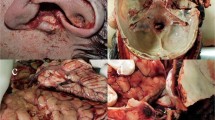Abstract
Introduction
Domestic accidents resulting in head injury are not uncommon. They mostly involve falls from high beds, tables or window seals. Rarely, children suffer penetrating skull injuries, often from unlikely objects.
Materials
We present two children, 2.5- and 1.5-year-old boys, respectively, who suffered penetrating wounds and compound depressed skull fractures when they fell from moderate height and landed on nearby electric mains plugs, which were driven into their heads. None of them lost consciousness or developed epilepsy. The first patient was brought with one plug pin firmly driven into the skull in the right frontal region. Parents had disassembled and removed the rest of the plug. The second patient was brought in with the whole plug attached and one pin embedded in the left parietal region. On plain radiographs and computed tomography (CT) scan, there was complete skull perforation, a compound depressed skull fracture, and the plug pin was embedded in the brain parenchyma in both patients. In the second patient, the injury site was near the motor cortex. In both cases, the plug was surgically removed, and the skull fracture was repaired.
Discussion
This type of injury from the protruding ends of mains plugs is uncommon and has to be borne in mind by parents, carers and any person dealing with childhood trauma because the plug could be removed at home and the child brought to the Emergency Department with only a small wound in the scalp, hiding a potentially serious underlying brain injury.




Similar content being viewed by others
References
DiMaio VJM, DiMaia DJ (1972) An unsuspected stab wound of the brain: case report. Mil Med 137:434
Dempsey LC, Weinstock DP, Hoff JT (1977) Stab wounds of the brain. West J Med 126:1
Koestler J, Keshavarz R (2001) Penetrating head injury in children: A case report and review of the literature. J Emerg Med 21:145–150
Dujovny M, Osgood C, Maroon J (1975) Penetrating intracranial foreign bodies in children. J Trauma 15:981–986
Domingo Z, Peter JC, de Villers JC (1994) Low velocity penetrating foreign craniocerebral injury in childhood. Pediatr Neurosurg 21:45–49
Sotiropoulos SV, Jackson MA, Tremblay GF et al (1990) Childhood lawn dart injuries: summery of 75 patients and patient report. Am J Dis Child 144:980–982
Duffy GP, Bhandari YS (1969) Intracranial complications following transorbital-penetrating injuries. Br J Surg 56:685–688
Regev E, Constantini S, Pomeranz S, Sela M, Shalit M (1990) Penetrating craniocerebral injury caused by a metal rod: an unusual case report. Injury 21:414–415
Miller CF, Brodkey JS, Colombi BJ (1977) The danger of intracranial wood. Surg Neurol 7:95–103
Tay JS, Garland JS (1987) Serious head injuries from lawn darts. Pediatrics 79:261–263
Geller E, Yoon MS, Loiselle J, Crisci KL (1997) Head injuries in children from plastic hairbeads. Pediatr Radiol 27(10):790–793
Buckingham MJ, Crone KR, Ball WS et al (1988) Traumatic intracranial aneurysms in childhood: two cases and a review of literature. Neurosurgery 22:398–408
Haddad F, Manktelow A, Brown M, Hope P (1996) Penetrating head injuries: a trap for the unwary. Injury 27:72–73
Kaufman HH, Schwab K, Salazar AM (1991) A national survey of neurosurgical care for penetrating head injury. Surg Neurol 36:370–377
Lewis RJ, Yee L, Inkelis SH, Gilmore D (1993) Clinical predictors of post-traumatic seizures in children with head trauma. Ann Emerg Med 22:1114–1118
Hennes H, Lee M, Smith D et al (1988) Clinical predictors of severe head trauma in children. Am J Dis Child 142:1045–1051
Dietrich AM, Bowman MJ, Ginn-Pease ME et al (1993) Pediatric head injuries: can clinical factors reliably predict an abnormality on computed tomography? Ann Emerg Med 22:1535–1540
Author information
Authors and Affiliations
Corresponding author
Rights and permissions
About this article
Cite this article
Kanagarajan, A., Sgouros, S. Unusual penetrating cranio-cerebral injuries in children from mains plugs. Childs Nerv Syst 23, 1181–1183 (2007). https://doi.org/10.1007/s00381-007-0365-y
Received:
Published:
Issue Date:
DOI: https://doi.org/10.1007/s00381-007-0365-y




